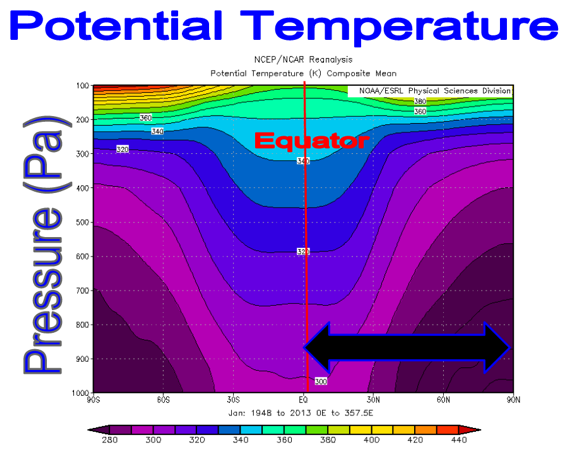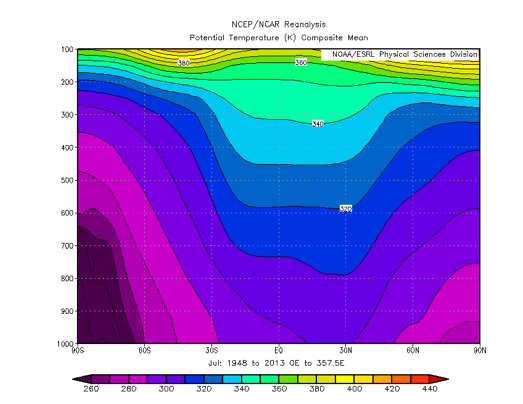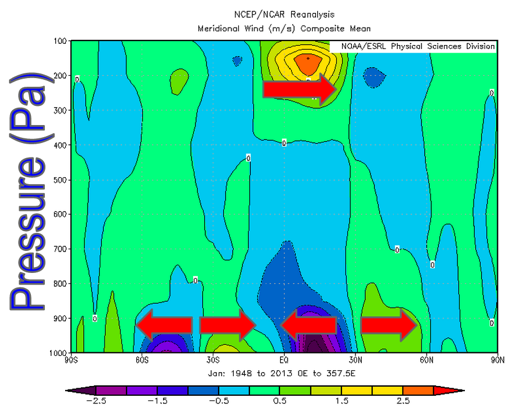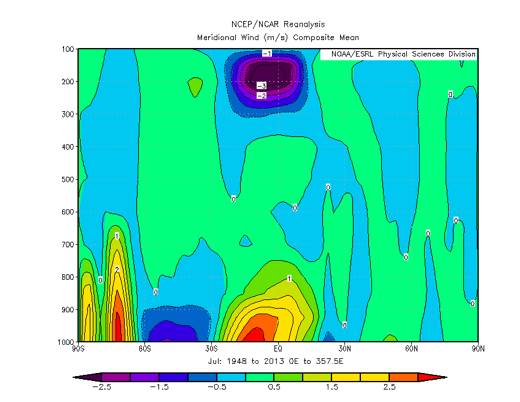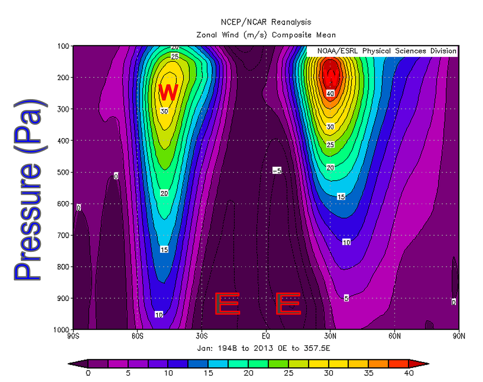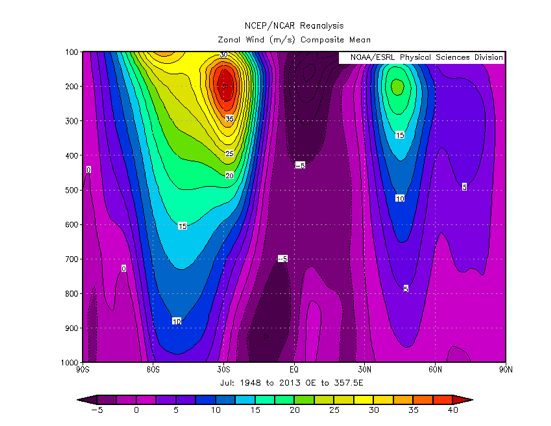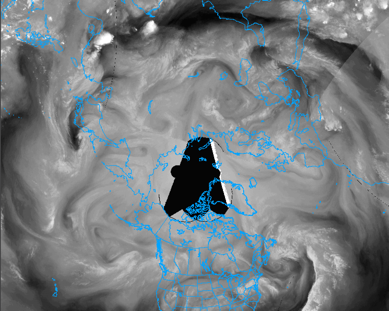...
where Ω = 0.1046 rad/sec, α = 207 * 10^-6^ K^-1, and dT/dr = 35.7 C/m. du/dz ended up to be 0.34 s^-1 from those values. The surface velocity was 0.054 m/s. The Hadley circulation is axisymmetric, especially in due to thermal wind balance with the radial temperature gradient.
(Costa……not sure what else to say from those numbers above…)
Atmospheric Examples
We have evidences the circulation from climatological plots of February:
(insert plots)
Eddy Circulation
Eddies are formed at high rotation rates and at middle to high latitudes. Coriolis forces have more effect, in this case. Due to the rotation, the Coriolis forces overpower pressures from temperature gradients, so the Hadley circulation breaks down. However, the heat must be transported from the tropics to the sub-tropics and the poles:
...
The power required to melt the ice is the latent heat of the ice times the amount of ice, divided by the amount of time it took for the ice to melt. L = 333 KJ/kg, m = 1.2 kg, t = 27 min (1624 sec), which came out to 0.246 2 kJ/s (246 200 Watts).
However, we also want to see how much of heat was transported by the eddies:
...
The area of the cylindrical surface at radius of 10 cm was 0.1 m^2. The velocity was .005 m/s. Using those values, the heat flux came out to 0.277 3 kJ/s (277 300 Watts).
The values of the fluxes, 246 200 Watts and 277 300 Watts, are close to each other even though the values are different (as long they are in the same order of magnitude).
Atmosphere
As in the tank experiments, two regimes of circulation and energy transport are observed on earth. Differential heating takes place between the Earth’s equator and the poles. This differential heating sets up a large scales circulation pattern which is affected by Earths rotation.
In the tropics, the Coriolis parameter is relatively small and the influence of Earth’s rotation is weak. In this regime, the Hadley circulation prevails, transporting energy from the equator to a latitude of roughly 30N. As air over the equator warms, it begins to rise into the upper atmosphere. It than diverges poleward, acquiring angular momentum as it travels to higher latitudes. At the edge of the Hadley cell (30N) the air sinks to surface and begins to travel towards the equator again. Evidence of the Hadley circulation can be observed in the following NCEP reanalysis plots. The plots can be found at: http://www.esrl.noaa.gov/psd/cgi-bin/data/composites/printpage.pl
In this plot of potential temperature, we see evidence of fundamentally warmer air over the equator (indicated by the red vertical line). Note how the temperature gradient varies between January and July. The gradient between the equator and the north pole is much less pronounced during July.
(Climatological plot of January 1948 to 2013)
(Climatological plot of July 1948 to 2013)
Poleward movement of fluid can is observed the following plot of zonally averaged Meridional Wind Flow. Note the surface divergence at 30 N and 30 S, where sinking air at the edge of the Hadley circulation encounters Earth’s surface.
In July, the surface divergence at 30N becomes significantly weaker. The divergence at 30S appears to significantly stronger.
As air parcels travel poleward, they are deflected by the Coriolis force. Furthermore, these parcels acquire a certain amount of angular momentum as they move closer the Earth’s axis of rotation. This deflection leads to the formation of a narrow stream of air at around 200 mb known as the jet stream (marked with ‘W” below). At the surface, parcels bound for the equator are steered right, forming surface easterly winds (marked with “E” below).
...
In the midlatitudes, atmospheric circulation is greatly influence by the earth's rotation. In this regime, the Rossby number is higher (relative to the Rossby number at the equator). The primary method of heat transport in this regime are eddies. These eddies make up what are known as mid-latitude weather systems. Below is a water vapor satellite image of the north pole on May 23, 2014 (found at http://climate.cod.edu/flanis/satellite/polar/index.php?type=polar-wv-48). The swirling eddies can very easily be made out.
Two Regimes of Heat Transport
